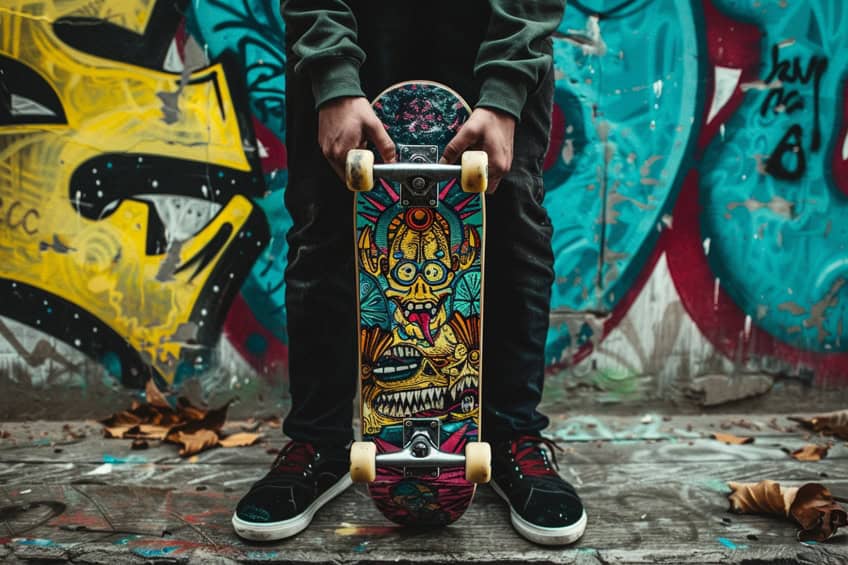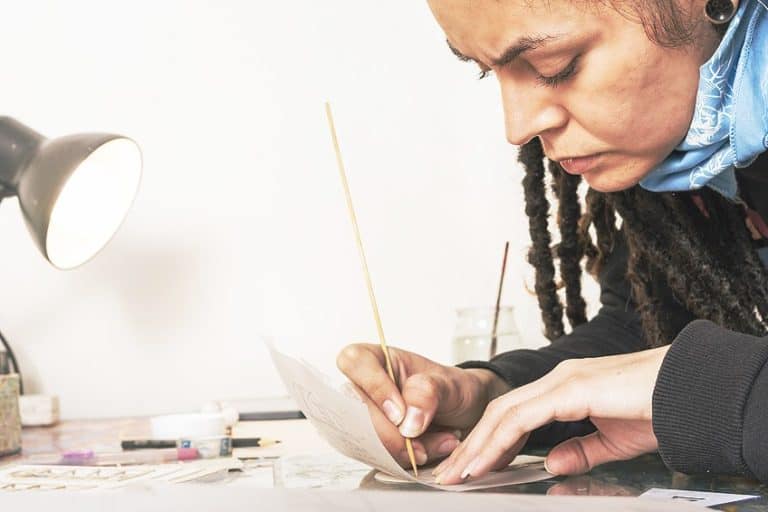Skateboard Art – Riding on Creativity
Skateboard art is like the rebellious cousin of traditional art forms, where creativity meets gravity-defying stunts. Imagine a canvas that’s not just flat but flips, twists, and grinds its way through urban landscapes. From vibrant graffiti-inspired designs to mind-bending illusions, skateboard art is where artists shred the boundaries of imagination. Join me as we dive into the colorful world where decks become masterpieces and every kickflip tells a story!
Table of Contents
Key Takeaways
- Skateboard art emerged as an extension of surf culture and has become a distinctive form of self-expression.
- The artwork on skateboard decks captures a spectrum of styles, often reflecting the skater’s individuality or the skateboarding community.
- Skateboard decks double as artwork for home interiors, symbolizing modern aesthetics and countercultural flair.

Origins of Skateboard Art
Skateboard art occupies a unique niche that seamlessly blends function and style, reflecting the dynamic energy of the sport itself. From simple beginnings in the 1960s as an offshoot of surf culture, skateboard art has evolved into a vibrant form of expression. Skaters originally decorated their boards with simple designs and stickers that were heavily influenced by the aesthetics of surfing.
Over time, these personal touches grew into a sophisticated art form that often conveys the skater’s personality or the board brand’s ethos.
As this artistic movement flourished, skateboard decks transformed into canvases for intricate artwork, spanning a wide range of styles and subjects. Professional artists and skaters alike contribute to the ever-growing gallery of designs, which include everything from graphic illustrations to elaborate pieces by renowned artists. Beyond the streets and skate parks, skateboard art has even rolled into the realm of home decor, where decks are displayed as symbols of cultural identity and avant-garde taste.
Influential Skateboard Artists
Jean-Michel Basquiat and Keith Haring are prominent figures who ventured into the world of skateboard art, though their work predominantly occupied larger canvases of public space and galleries. Other significant contributors include Ed Templeton, whose graphics reflect his own experiences in skateboarding and life, often intertwined with a gritty aesthetic. The integration of their unique styles helped elevate skate decks from mere sporting equipment to canvases for personal and cultural expression.
- Jean-Michel Basquiat: Used symbolism and commentary on societal structures within his art, which found its way onto skate decks posthumously, bridging fine art and street skate culture.
- Keith Haring: Renowned for his public works that often featured bold lines and vivid colors, Haring’s skate art continues to resonate within the community.
- Ed Templeton: A professional skateboarder and artist whose work is often autobiographical, capturing the rawness of youth and skate culture.

Cultural Impact
The relationship between graffiti and urban culture had a profound influence on skateboard art. The mobility of skateboards meant that designs and symbols carried on them became a moving part of the urban canvas. Artists like Basquiat and Haring contributed to a visual language that encapsulated the ethos of street culture.
- Graffiti’s influence: Bold graphics and vibrant colors commonly found in graffiti art transitioned smoothly onto skate decks.
- Urban culture: Skateboarding itself became a symbol of urban subculture, and its art became a form of identity for skaters, encapsulating their defiance, freedom, and creative spirit.
The interplay between influential artists and the growing popularity of skateboarding has helped push the boundaries of traditional art forms, positioning skateboard decks as noteworthy collectibles and significant pieces of cultural manifestation.
Designing Skateboard Decks
The intricate art of designing skateboard decks combines the functional needs of a skater with diverse visual expressions, ranging from street-inspired illustrations to aesthetic pieces suited for display as wall art in any setting including a man cave.
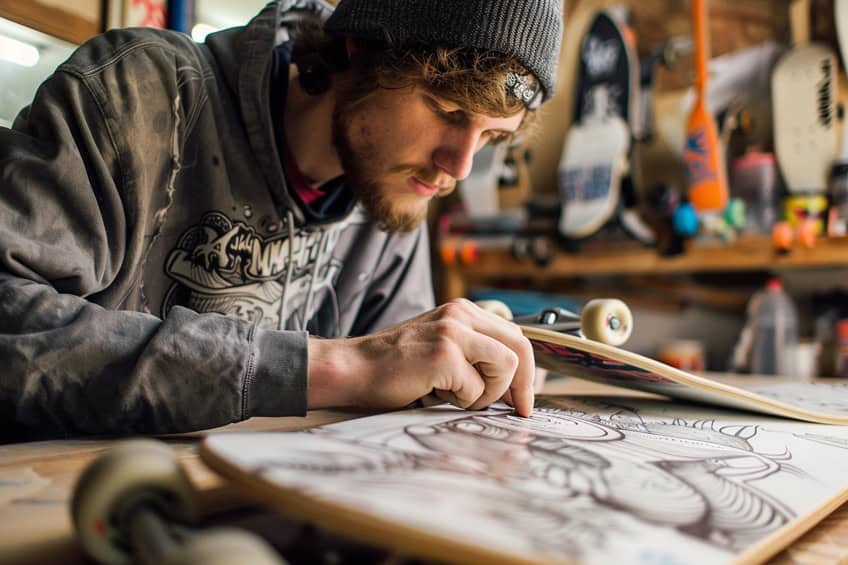
Creative Process
The creative process for designing skateboard decks often begins with understanding the culture and interests of the skating community. Artists take inspiration from various sources, including street art, graphic design, and contemporary themes, to create designs that resonate with skaters. Illustrations can range from bold graphics to intricate artistry, often reflecting the skater’s personality or the character they want to portray.
Typically, a sketching phase is followed by digital or hand-painting techniques to bring the designs to life.
- Sketching: Foundation for the artistic concept.
- Digital illustration: Refinement and digitization of the initial sketches.
- Manual artistry: Application of hand-painting techniques for unique deck art.
Design Principles
When crafting skateboard deck art, adhering to design principles ensures that the final product is not only visually appealing but functional as well. Designers must consider the balance of elements, ensuring that the artwork complements the shape of the deck. Color choice is crucial; it must captivate yet withstand the wear and tear inherent to the sport. The symmetry and alignment of the artwork can also affect how a design is perceived when the deck is in motion. Design considerations for skateboard deck art include:
- Functionality: Art does not impede the skateboarding experience.
- Durability: Selection of materials that maintain integrity under stress.
- Aesthetic: Artwork that stands out, whether on the move or mounted as decor.
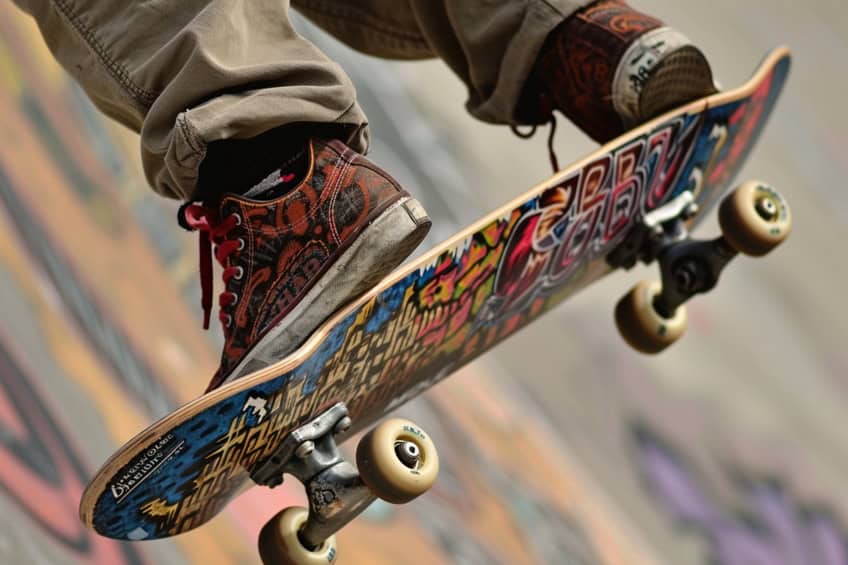
Skateboard Art as Home Decor
Skateboard art has transcended sports and become a stylish element in home decor. Collectors and enthusiasts use boards as unique pieces of wall art, creating vibrant and personal interior designs.
Incorporating into Interiors
Deploying skateboard decks as wall art offers a contemporary look to any room. They can be arrayed as a single statement piece or grouped to form a larger installation. A collector might also choose to display limited edition decks or boards with sentimental value. Options for arrangement include being vertically stacked, horizontally aligned, and using a grid formation.

Through platforms like Etsy, skateboard decks can often be customized or made-to-order. Add your personalization at checkout for a bespoke piece of art that reflects individual taste. A skateboard deck with bold graphics can serve as an accent gift for music home decor or function as a pivotal piece of a room’s aesthetic.
Acquiring Skateboard Art
These platforms are hotspots for obtaining skateboard wall art. They champion a diverse range of styles, from handmade to vintage, and often include unique craft supplies and digital items.
- Small businesses and independent artists: Often, the creators behind Etsy listings are small businesses focusing on handmade or upcycled decor.
- Made-to-order: Many sellers provide options that allow buyers to commission artwork that truly represents their style and interests.
- Included shipping: Some listings offer the perk of free shipping, lowering the overall cost and incentivizing the purchase of skateboard deck wall art as home decor.
Communal and Global Dimensions
Skateboard art transcends local communities, fostering global connections and preserving cultural heritage through collaboration and social initiatives. It becomes a canvas for expression that unites artists, skaters, and collectors from diverse backgrounds.
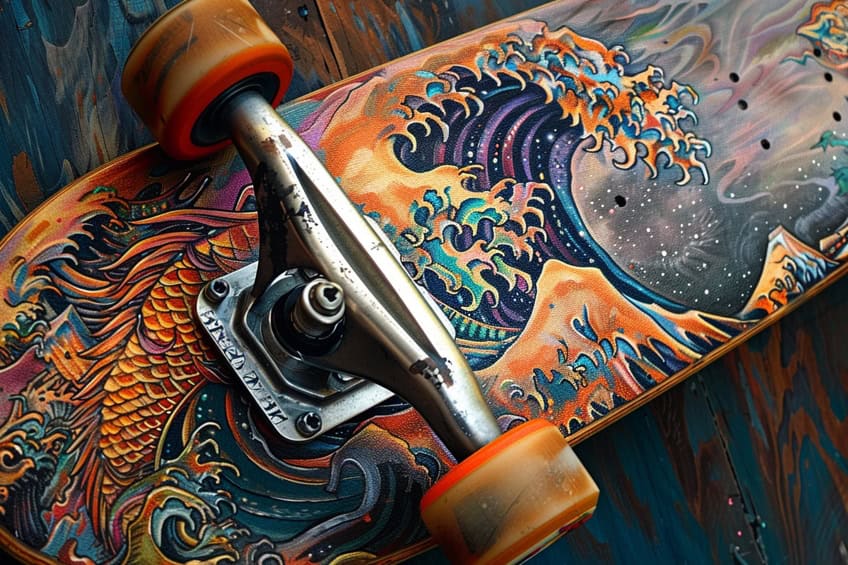
Skate Art Collaboration
The Skateroom is a notable example of global collaboration, bringing together artists from various cultural backgrounds to craft skateboard art. They reinterpret traditional works, creating triptychs or single decks that often include imagery such as Japanese cherry blossoms, symbolizing a bridge between East and West.
These collaborations often result in limited edition pieces sought after by collectors worldwide.
- Social skate projects: A percentage of sales—often around 10%—from these collaborations is directed to social skate projects. This not only supports local communities but also contributes to the global network, reinforcing skateboarding’s position as a socially responsible art form.
Preserving Skate Art Culture
Preserving the cultural heritage of skateboarding involves documenting and supporting the art that decorates skateboards. Exhibitions and auctions, like the Sotheby’s event where a complete set of 248 artist decks was auctioned, recognize the art’s value and contribute to its preservation.

As we wrap up our journey through the world of skateboard art, one thing is clear: this isn’t just about boards and wheels—it’s a culture, a statement, and a canvas that defies convention. From the streets to galleries, skateboard art has carved its place as a vibrant and dynamic form of expression. So whether you’re a seasoned skater or an art enthusiast looking for something fresh, remember, the next time you see a deck, it might just be a work of art waiting to roll into your imagination. Keep shredding and keep creating!
Frequently Asked Questions
How Can I Create My Own Skateboard Art?
One can create their own skateboard art by first smoothing the board with sandpaper, applying a primer, and then adding their chosen paint design. Finishing with a clear coat will protect the artwork.
What Techniques Are Used by Artists to Paint Skateboards?
Artists often use sanding to prepare the surface, followed by layering primer, paint, and clear coat to produce durable and visually appealing skateboard art. They may employ spray painting, stencil art, or hand painting for intricate designs.
How Can Skateboard Art Be Preserved and Protected?
Protect skateboard art by applying a clear protective coat over the paint, which guards against scratches and weather damage. Regularly clean the skateboard and store it away from direct sunlight and moisture to maintain the art’s vibrancy.
Are There Any Notable Artists Known for Their Skateboard Art?
Several celebrated artists, including Damien Hirst, Cindy Sherman, and Jeff Koons, have created designs for skateboards. These artist boards have gained recognition in the art world, with collections even being auctioned at institutions like Sotheby’s.
Isabella studied at the University of Cape Town in South Africa and graduated with a Bachelor of Arts majoring in English Literature & Language and Psychology. Throughout her undergraduate years, she took Art History as an additional subject and absolutely loved it. Building on from her art history knowledge that began in high school, art has always been a particular area of fascination for her. From learning about artworks previously unknown to her, or sharpening her existing understanding of specific works, the ability to continue learning within this interesting sphere excites her greatly.
Her focal points of interest in art history encompass profiling specific artists and art movements, as it is these areas where she is able to really dig deep into the rich narrative of the art world. Additionally, she particularly enjoys exploring the different artistic styles of the 20th century, as well as the important impact that female artists have had on the development of art history.
Learn more about Isabella Meyer and the Art in Context Team.
Cite this Article
Isabella, Meyer, “Skateboard Art – Riding on Creativity.” Art in Context. April 22, 2024. URL: https://artincontext.org/skateboard-art/
Meyer, I. (2024, 22 April). Skateboard Art – Riding on Creativity. Art in Context. https://artincontext.org/skateboard-art/
Meyer, Isabella. “Skateboard Art – Riding on Creativity.” Art in Context, April 22, 2024. https://artincontext.org/skateboard-art/.


